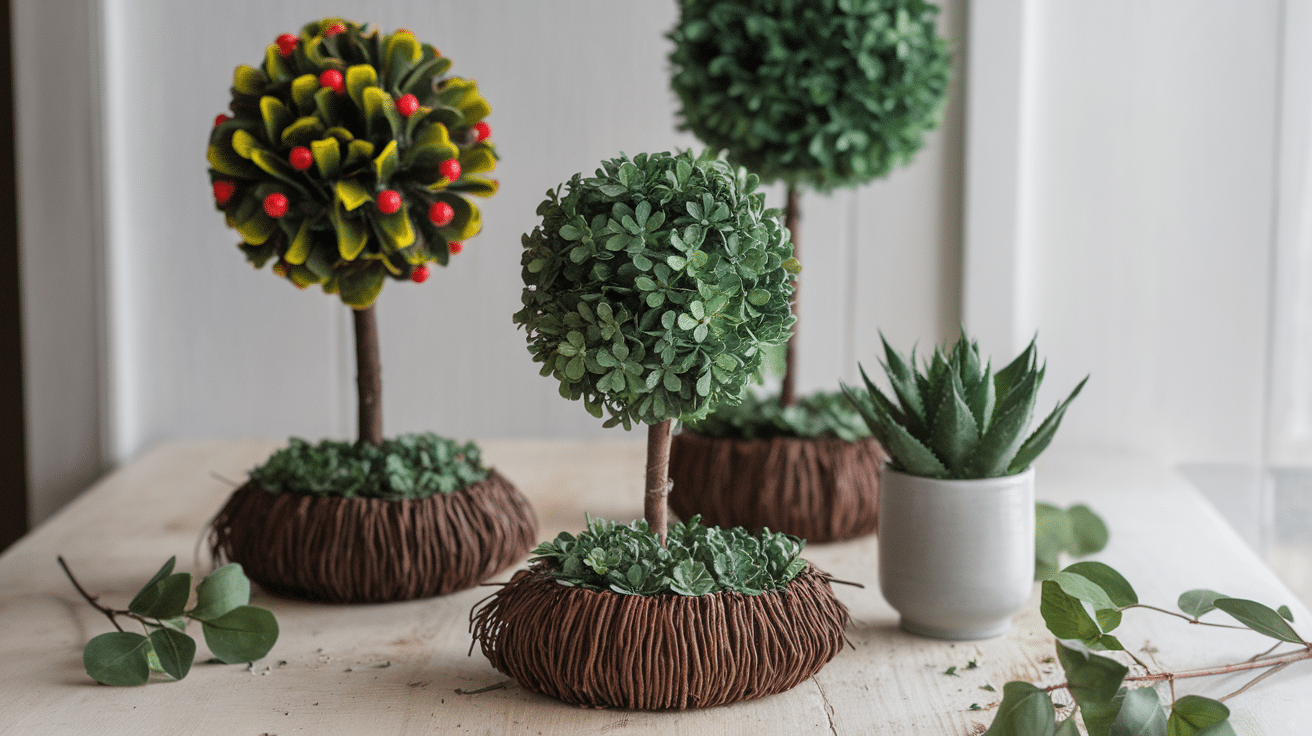Change your space with the timeless grace of topiaries—without the decades of waiting! While traditional gardeners might spend years nurturing and pruning living sculptures, our clever pool noodle hack delivers instant gratification with surprising sophistication.
These statement pieces bring a touch of European garden charm to any setting, from urban balconies to sprawling patios.
Even better? Unlike their fussy living counterparts, these handcrafted beauties require no watering, survive in any climate, and won’t outgrow their perfect form.
Ready to fool guests with your “green thumb” masterpiece that took hours instead of years? Let’s start creating these no-maintenance marvels that blend classic garden artistry with modern ingenuity!
Why Choose DIY Topiaries?
Ever walked through a high-end garden center and gasped at the price tags on those perfectly shaped topiaries? You’re not alone! Professional topiaries can command hundreds of dollars, yet with a little creativity and about $30 in materials, you can create stunning replicas that even experienced gardeners will admire.
These lightweight, versatile decorative pieces become instant focal points, whether framing your entryway, defining outdoor living spaces, or adding vertical interest to barren corners.
The secret? Reimagining everyday items like pool noodles and faux boxwood into sophisticated garden art. Perfect for apartment dwellers craving greenery without maintenance headaches, renters wanting portable decor, or anyone seeking weather-resistant beauty that requires zero gardening skills.
Best of all, you can customize every aspect—from height and shape to base and seasonal embellishments—creating truly one-of-a-kind pieces that reflect your style.
Tools and Materials Needed
| Item | Purpose |
|---|---|
| Scissors | Cutting boxwood panels |
| Wire cutters/pliers | Straightening/cutting wire |
| Hot glue gun & sticks | Bonding materials |
| Pool noodles (3) | Main structure |
| Wire coat hangers | Internal support |
| Brown spray paint | Camouflaging foam |
| Faux boxwood panels | Greenery covering |
| Thin gauge wire | Securing panels |
| Decorative container | Base for topiary |
| Straight branch | Trunk support |
| Vines & dried branches | Natural detailing |
| Styrofoam pieces | Base stability |
Step-by-Step Guide for DIY Topiaries
Step 1: Planning Your Topiary
Measure for your topiary dimensions, aiming for a container height of about 18 inches plus 44 inches for the topiary itself. Choose a sturdy container with sufficient depth to hold your creation securely.
Fill the container with Styrofoam pieces to provide stability without adding significant weight and to prevent water damage if placed outdoors. This preparation ensures your topiary remains lightweight and easy to relocate as needed.
Step 2: Preparing the Pool Noodles
Using pliers, straighten wire coat hangers, flattening the wire at the crease for easier handling. Feed the straightened wire through the center of each pool noodle.
The wire won’t run the entire length, which is fine. Bend down the loop end of the hanger and secure it in place, creating connection points at each end of the pool noodles for the next step.
Step 3: Connecting the Pool Noodles
Position the pool noodles end to end, connecting the wire loops with a small piece of wire. Apply hot glue generously around the connection point and press the pieces firmly together. Hold for five minutes to allow the glue to melt the foam slightly, creating a permanent bond. Once cooled, you’ll have a single tube for your topiary structure.
Step 4: Shaping Your Topiary
Create the curved topiary shape by making deliberate bends in the wire, twisting slightly as you work around the form. Secure the tree branch at your chosen midpoint.
For a tapered appearance, attach half a pool noodle around the base, creating a thicker bottom that gradually narrows toward the top for a more natural look.
Step 5: Creating the Base
Secure your shaped topiary to the straight branch and position it in your styrofoam-filled container. Add decorative vines around the base to create a natural transition between the container and topiary while concealing the attachment point.
Secure vines with wire and adjust them for an appealing arrangement that improves the authenticity of your creation.
Step 6: Painting the Structure
Apply brown spray paint designed for plastic surfaces to your topiary structure. A light coating will camouflage the bright color of the pool noodles without requiring complete coverage.
This ensures that any gaps between the faux boxwood will blend naturally with the garden’s artistic style. Allow the paint to dry completely before proceeding to the next step.
Step 7: Applying the Faux Boxwood
Cut boxwood panels into three equal strips, approximately 3 inches wide. For the top, create a hood shape by folding one strip and securing the edges with wire.
Place this over the top of your form and secure it. Continue adding strips, overlapping them slightly and securing them with wire as you work downward, adjusting your technique as you reach the wider base section.
Step 8: Finishing Touches
Check your covered topiary for gaps and fill these with leftover boxwood pieces secured with hot glue. Insert small dried branches between layers to create the appearance of recently trimmed growth.
Make final adjustments to the overall shape, checking from different angles until you achieve the desired appearance. Your handcrafted topiary is now ready for display.
Video Tutorial
Check out this YouTube video for a detailed step-by-step Tutorial by Suzy Rebelo.
Expert Tips to Keep Your Topiary Fresh and Vibrant Year-Round
Topiaries add a beautiful touch to your garden or home décor, but maintaining their beauty requires a little care and attention. Here are some essential hacks to keep your topiary looking fresh and vibrant all year round:
1. Regular Dusting
Fake topiaries tend to collect dust, which can dull their appearance over time. Use a hairdryer on the cool setting to gently blow away loose particles. For more thorough cleaning, wipe down the leaves with a microfiber cloth to remove fine dust without damaging the foliage.
2. Protect from the Elements
Topiaries placed outdoors are exposed to varying weather conditions. To prevent sun fading, apply a clear weatherproof sealant. For those in areas with extreme weather, consider moving your topiary to a sheltered spot during storms or harsh winters, or use protective covers for extra care.
3. Trim and Shape Periodically
Over time, topiary shapes can become uneven. Keep the shape intact by trimming any unruly branches with sharp scissors or pruning shears. Lightly trim the foliage to maintain the sculpted look. Rotate the topiary occasionally to ensure even growth or wear, especially if it’s displayed in a spot with uneven sunlight.
4. Keep it Clean and Moisture-Free
For a deep clean, mix a mild dish soap solution and gently rinse the topiary’s leaves. Avoid soaking it, as excess moisture can cause mold or mildew. For stubborn stains, create a solution with white vinegar (1 part vinegar to 4 parts water) to restore the appearance without damaging the plant.
5. Apply UV Protection
To keep your faux topiary vibrant for longer, apply a UV protectant spray. This helps to shield the leaves from harmful rays that cause fading. These sprays are designed to maintain the color and prevent discoloration, ensuring your topiary stays looking fresh.
What Not to Do in DIY Topiaries
| Issue to Avoid | Potential Consequence | Prevention Method |
|---|---|---|
| Insufficient drying time after gluing | Structure separation and collapse | Allow a full 5-10 minutes of holding time for each glued section |
| Weak base support | Topiary tipping over | Use adequate styrofoam in the base; consider adding weight if necessary |
| Excessive force when shaping | Breaking internal wire support | Make gradual, gentle bends rather than sharp angles |
| Direct prolonged sunlight | Fading and material deterioration | Move periodically or use UV-resistant spray |
| Over-wetting during cleaning | Water damage to the internal structure | Use minimal moisture and allow full drying between cleanings |
| Incomplete paint coverage | Visible bright foam beneath the boxwood | Apply paint thoroughly to all areas that might show through |
| Loose boxwood attachment | Gaps develop over time | Secure thoroughly with both wire and glue |
| Top-heavy design | Instability and falling | Ensure proper balance with a wider base than the top |
Conclusion
Your handcrafted topiary stands as a testament to creativity triumphing over convention—a perfect fusion of resourcefulness and dignity.
While garden centers charge premium prices for similar decorative pieces, you’ve crafted something uniquely yours at a fraction of the cost.
The beauty of these verdant sculptures lies not just in their appearance but in their resilience—they weather seasons without wilting, maintain perfect form without pruning, and breathe life into spaces year-round.
As you admire your finished creation, remember that true garden magic isn’t always about what grows from soil but what blossoms from imagination.
Your topiary trip doesn’t end here—it continues with each season, each creative embellishment, and each admiring glance from impressed visitors!
















